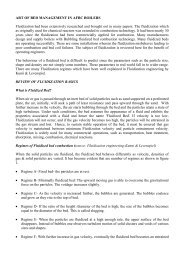You also want an ePaper? Increase the reach of your titles
YUMPU automatically turns print PDFs into web optimized ePapers that Google loves.
TANJORE PAINTINGS<br />
Tanjore (or Thanjavur or Thanjavoor) pa<strong>in</strong>t<strong>in</strong>gs have a<br />
very rich heritage. This style of pa<strong>in</strong>t<strong>in</strong>g has been followed<br />
widely by the people <strong>in</strong> Southern Tamil Nadu for the past two<br />
centuries. The art flourished <strong>in</strong> Tanjavoor, pronounced<br />
Tanjore, the capital city of the Chola dynasty, and thus got its<br />
name. Mar<strong>at</strong>ha pr<strong>in</strong>ces, Nayaks of Vijaynagar dynasty, Rajus<br />
communities of Tanjore and Trichy and Naidus of Madurai<br />
p<strong>at</strong>ronized the art of Tanjore pa<strong>in</strong>t<strong>in</strong>g from 16 to 18th<br />
centuries. Tanjore pa<strong>in</strong>t<strong>in</strong>gs are deeply rooted <strong>in</strong> tradition and<br />
still <strong>in</strong>nov<strong>at</strong>ive with<strong>in</strong> limits. This art is sacred and dedic<strong>at</strong>ed.<br />
The pa<strong>in</strong>t<strong>in</strong>gs are notable for their adornment <strong>in</strong> the form of semi-precious stones, pearls, glass<br />
pieces and gold. The rich vibrant colors, dashes of gold, semi-precious stones and f<strong>in</strong>e artistic work<br />
are characteristics of these pa<strong>in</strong>t<strong>in</strong>gs. They add beauty and culture to a variety of surround<strong>in</strong>gs and<br />
décor. The pa<strong>in</strong>t<strong>in</strong>gs are mostly of Gods and Goddesses because this art of pa<strong>in</strong>t<strong>in</strong>g flourished <strong>at</strong> a<br />
time when f<strong>in</strong>e-look<strong>in</strong>g and strik<strong>in</strong>g temples were be<strong>in</strong>g constructed by rulers of several dynasties.<br />
The figures <strong>in</strong> these pa<strong>in</strong>t<strong>in</strong>gs are large and the faces are round and div<strong>in</strong>e.<br />
Trac<strong>in</strong>g its roots to the historical golden era of the early 18th century, Tanjore artwork is one of the<br />
many <strong>in</strong>digenous art forms for which India is noted. Orig<strong>in</strong><strong>at</strong><strong>in</strong>g <strong>in</strong> Tanjore about 300 kms from<br />
Chennai ( Madras), which was the then capital of the Gupta empire, this form of art developed <strong>at</strong> the<br />
height of cultural evolvement achieved dur<strong>in</strong>g th<strong>at</strong> period. Crafted with meticulous care the<br />
Thanjavoor (Tanjore) pictures are unique. Wh<strong>at</strong> sets them apart from Indian pa<strong>in</strong>t<strong>in</strong>gs <strong>in</strong> general are<br />
the embellishments made over the basic draw<strong>in</strong>gs with precious and semi-precious stones as well as<br />
the relief work which gives them a three dimensional effect. The pictures are of various sizes,<br />
rang<strong>in</strong>g from huge works spann<strong>in</strong>g whole walls to small m<strong>in</strong>i<strong>at</strong>ures no longer than 6-<strong>in</strong>ch square.<br />
The pa<strong>in</strong>t<strong>in</strong>gs decor<strong>at</strong>e the puja rooms <strong>in</strong> residences, arcades <strong>in</strong> major hotels and lobbies <strong>in</strong> Corpor<strong>at</strong>e<br />
Offices. They also make nice gifts for Diwali, Wedd<strong>in</strong>gs and other special occasions.<br />
Technique<br />
The process of mak<strong>in</strong>g a Tanjore pa<strong>in</strong>t<strong>in</strong>g <strong>in</strong>volves many stages. The first stage <strong>in</strong>volves the mak<strong>in</strong>g<br />
of the prelim<strong>in</strong>ary sketch of the image on the base. The base consists of a cloth pasted over a wooden<br />
base. Then chalk powder or z<strong>in</strong>c oxide is mixed with w<strong>at</strong>er-soluble adhesive and applied on the base.<br />
To make the base smoother, a mild abrasive is sometimes used. After the draw<strong>in</strong>g is made,<br />
decor<strong>at</strong>ion of the jewellery and the apparels <strong>in</strong> the image is done with semi-precious stones also<br />
known as Jaipur stones. Laces or threads are also used to decor<strong>at</strong>e the jewellery. On top of this, the<br />
gold foils are pasted. F<strong>in</strong>ally, dyes are used to add colors to the figures <strong>in</strong> the pa<strong>in</strong>t<strong>in</strong>gs. High-quality<br />
gold foil is used to ensure th<strong>at</strong> the pa<strong>in</strong>t<strong>in</strong>gs last gener<strong>at</strong>ions. They generally appreci<strong>at</strong>e <strong>in</strong> value and<br />
are considered collectibles. Pa<strong>in</strong>t<strong>in</strong>gs come <strong>in</strong> three f<strong>in</strong>ishes, Classic, Antique Style and Embossed.<br />
In the classic f<strong>in</strong>ish, bold colors and strik<strong>in</strong>g backgrounds are comb<strong>in</strong>ed with high-glitter gold foil,<br />
while <strong>in</strong> the antique style, the gold's glitter is more sober, with more subtle colors and pla<strong>in</strong><br />
backgrounds. The embossed pa<strong>in</strong>t<strong>in</strong>gs are similar to the classic style but are embossed to br<strong>in</strong>g about<br />
more depth.<br />
In case you are <strong>in</strong>terested <strong>in</strong> hav<strong>in</strong>g a Tanjore pa<strong>in</strong>t<strong>in</strong>g of your favourite God / Goddess, contact<br />
Mrs.Meena Asokkumar <strong>at</strong> email ID- kasokku@gmail.com , meenaasokkumar@gmail.com.


















